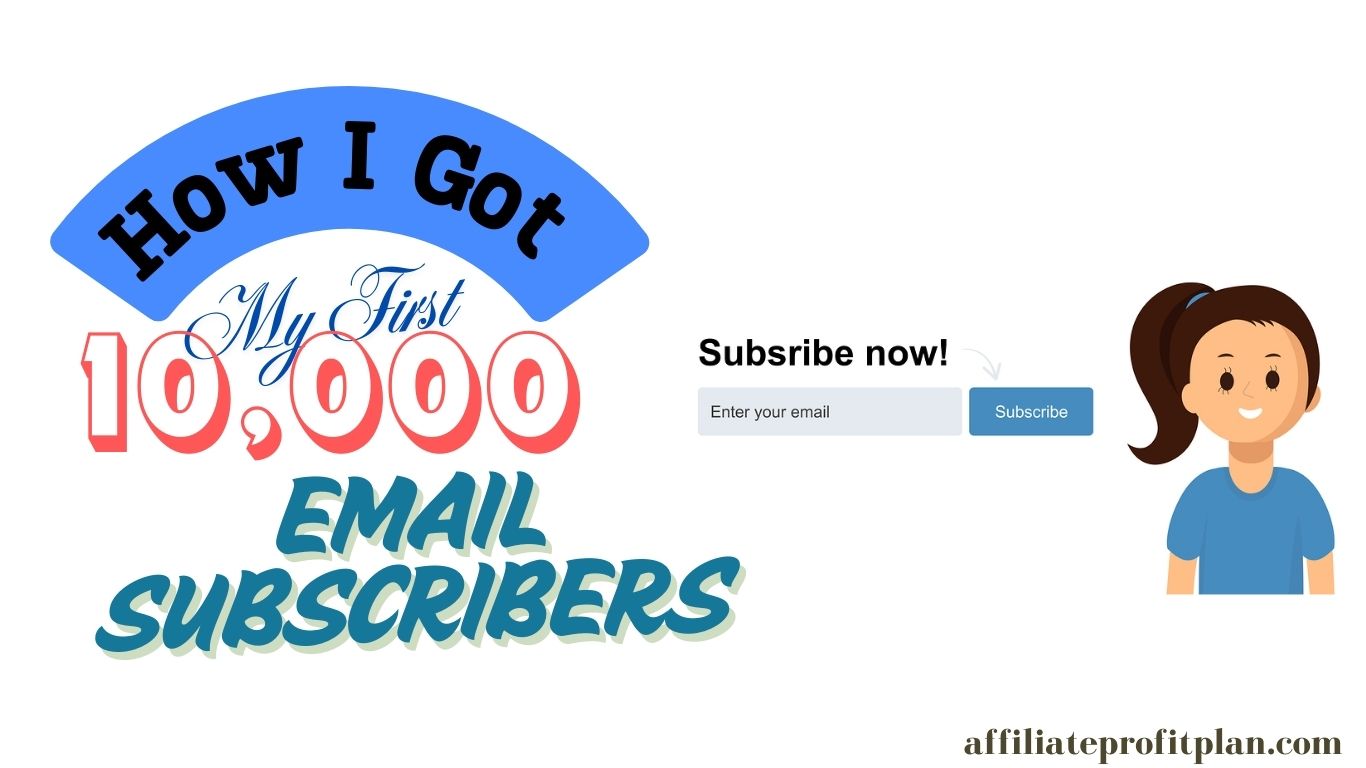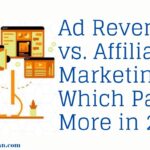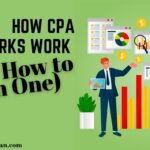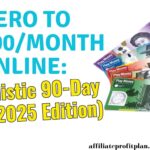Welcome to my article How I Got My First 10,000 Email Subscribers. When I first started building an email list, I had exactly three subscribers—me, my best friend, and my very supportive mom (who, to this day, still replies to my emails with “Proud of you!”). I used to think email marketing was old-school, something only corporate giants and spammers cared about. But then I realized something: email is where the real magic happens. Unlike social media, where algorithms can decide your fate overnight, your email list is yours—a direct line to an audience that actually wants to hear from you.
But growing from three subscribers to 10,000? That was no accident. It took a mix of strategy, patience, and a few mistakes along the way (like that time I accidentally sent an email with “Hey {First_Name}” to my entire list). Through trial and error, I cracked the code on how to attract, engage, and retain email subscribers without resorting to spammy tactics or desperate begging. In this post, I’ll walk you through the exact steps I used—from creating an irresistible lead magnet to driving targeted traffic and keeping subscribers engaged. If you’re ready to turn your email list into a thriving community (and not just your mom and a handful of bots), let’s dive in!
Access My Proven Blueprint for $50-$100 Daily Income – Watch This FREE Video Now >>>
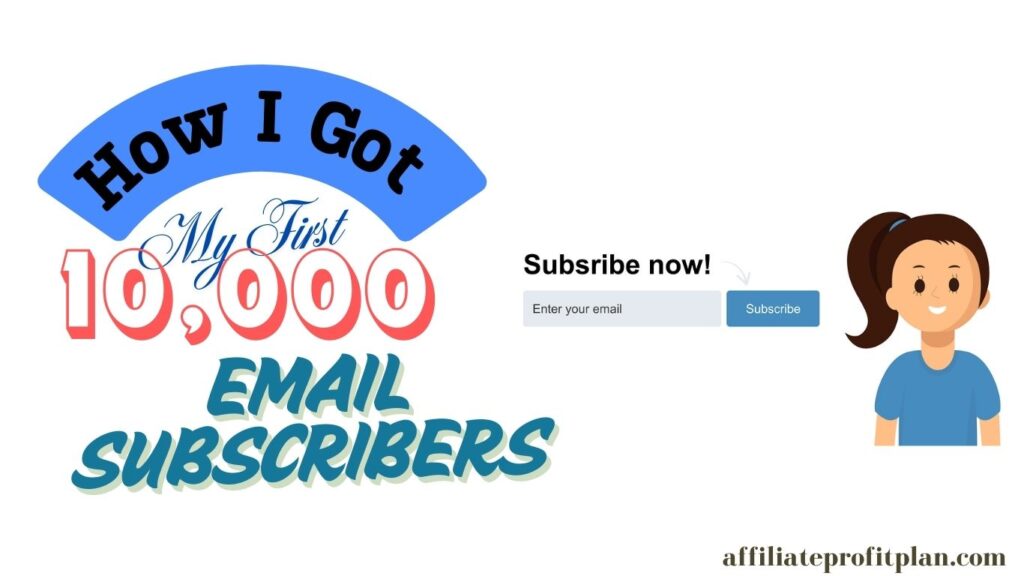
Choosing the Right Email Marketing Platform
Picking an email marketing platform is a bit like choosing a gym membership. You want something powerful, easy to use, and not so complicated that you need a PhD to send a simple email. The right platform can streamline your email marketing efforts, while the wrong one can leave you banging your head against your keyboard, wondering why your emails keep landing in spam.
When I first started, I made the rookie mistake of going for the cheapest option without really thinking about the features I needed. Turns out, not all email marketing platforms are created equal. Some are fantastic for automation and segmentation (hello, ConvertKit and ActiveCampaign), while others excel at user-friendliness and affordability (looking at you, Mailchimp and MailerLite). The key is to choose a platform that fits your current needs but can also grow with you—because trust me, once you start collecting subscribers like Pokémon, you’ll want more advanced features like tagging, A/B testing, and in-depth analytics.
Here are a few things I learned to look for:
✅ Ease of Use – If it takes three hours to figure out how to send a welcome email, it’s a no-go.
✅ Automation & Segmentation – Because sending personalized emails manually to thousands of people? Yeah, not happening.
✅ Deliverability – If your emails keep ending up in spam, your subscribers will never see them, and your open rates will cry.
✅ Pricing & Scalability – Many platforms have free plans, but check how much they charge as your list grows.
In the end, I settled on [your chosen platform] because it checked all my boxes—and trust me, having the right platform made all the difference. So, before you commit, test out a few options and find the one that makes email marketing feel like a breeze instead of a chore!
Creating an Irresistible Lead Magnet
Here’s the hard truth: no one is signing up for your email list just because you asked nicely. People guard their email addresses like a dragon hoarding gold, and honestly, who can blame them? Between spam, sales pitches, and that one newsletter you forgot you subscribed to in 2015, inboxes are already overloaded. If you want people to willingly hand over their precious email, you need to offer them something they actually want—and that’s where a killer lead magnet comes in.
A lead magnet is basically a bribe, but in a totally ethical way. It’s a freebie that’s so useful, so irresistible, that your audience can’t help but subscribe. But not all lead magnets are created equal. A generic “Sign up for my newsletter” is about as appealing as soggy toast. Instead, focus on solving a specific problem. Ask yourself:
- What’s a quick win I can give my audience?
- What’s so valuable that they’d happily trade their email for it?
- How can I make it immediate and actionable?
Some high-performing lead magnet ideas include:
✅ Ebooks & Guides – A short, practical PDF on a topic your audience cares about.
✅ Checklists & Templates – Who doesn’t love a done-for-you solution?
✅ Free Email Courses – Teach something valuable over a few days.
✅ Exclusive Content – Private blog posts, webinars, or even a secret resource library.
For my first 10,000 subscribers, I tested multiple lead magnets, and the winner was [insert what worked best for you—e.g., a “5-Step Blogging Blueprint” or “Ultimate SEO Checklist”]. Why? Because it was hyper-relevant, easy to consume, and delivered instant results.
Bottom line? Your lead magnet should make people excited to subscribe, not just willing. If it’s something they’d actually pay for—but you’re giving it away for free—then you’ve nailed it!
Driving Traffic to My Opt-in Forms
You’ve got a killer lead magnet, your email platform is ready to roll, and your opt-in form is looking sleek. Now comes the fun part—getting actual humans (not just your mom and a couple of bots) to see it. Because let’s be honest, the best lead magnet in the world won’t do much if no one knows it exists.
Access My Proven Blueprint for $50-$100 Daily Income – Watch This FREE Video Now >>>
When I first started, I made the classic mistake of putting my opt-in form in one random spot on my blog and calling it a day. Spoiler alert: that didn’t work. If you want people to sign up, you need to put your opt-in everywhere—and I mean everywhere.
Here’s what actually worked for me:
✅ Strategic Placement on My Website – I added my opt-in form:
- At the top of my homepage (because first impressions matter).
- Inside blog posts related to my lead magnet.
- In a sticky bar that follows visitors as they scroll.
- As an exit-intent popup (because FOMO is real).
✅ Leveraging Social Media – I didn’t just wait for traffic to magically appear. I:
- Created Pinterest pins linking to my lead magnet (Pinterest is basically a search engine in disguise).
- Shared my freebie in Facebook groups where my audience hangs out (without being spammy).
- Promoted it on Instagram Stories with a swipe-up link (or a “DM me for the link” call-to-action).
- Linked to it in my Twitter bio and pinned tweet.
✅ Guest Blogging & Collaborations – I wrote guest posts on sites with a bigger audience and included my opt-in at the end. I also joined podcast interviews and told listeners to grab my freebie.
✅ Using My Existing Email List – Yes, I used email to grow my email list (emailception!). Every time I sent an email, I reminded my subscribers to share my lead magnet with friends. Referral traffic is chef’s kiss.
The bottom line? More eyeballs = more subscribers. Don’t just tuck your opt-in form away like a hidden treasure—shout about it from the (digital) rooftops.
Nurturing Subscribers to Keep Them Engaged
Getting someone to subscribe to your email list is like getting a match on a dating app—it’s exciting, but the real challenge is keeping their interest so they don’t ghost you. You don’t want your new subscribers to forget who you are or, worse, hit that dreaded “unsubscribe” button faster than you can say “Wait, I have valuable content!”
When I first started building my email list, I made the classic mistake of collecting emails and then… doing absolutely nothing. A month later, I sent an email, and half my subscribers were like, “Who is this person and why are they in my inbox?” Lesson learned: you need to nurture your subscribers from day one.
Here’s what actually works:
✅ A Warm Welcome Sequence – The first few emails set the tone. Instead of just sending my lead magnet and disappearing, I created a 5-email welcome series that:
- Reminded them why they signed up in the first place.
- Introduced me and my brand (without a boring autobiography).
- Provided more value-packed content related to their interests.
- Encouraged them to reply to my emails (building that personal connection!).
✅ Consistent & Valuable Emails – If the only time you email your list is when you’re selling something, you’ll lose subscribers fast. I make sure to:
- Send weekly or bi-weekly emails so they remember me.
- Share helpful tips, personal stories, and behind-the-scenes insights.
- Occasionally ask questions or run polls to keep things interactive.
✅ Segmentation & Personalization – Not all subscribers are interested in the same thing. Instead of blasting everyone with the same content, I:
- Segment my list based on their interests and actions.
- Send personalized emails based on what they clicked on.
- Make subject lines and content feel like I’m talking to a friend (because no one likes robotic emails).
✅ A Little Fun & Personality – No one wants to read emails that feel like a corporate memo. I keep my emails light, engaging, and a little fun—whether it’s using humor, emojis, or GIFs.
The goal? Make your subscribers excited to hear from you. If you show up consistently with value, personality, and genuine connection, your subscribers won’t just stick around—they’ll actually look forward to your emails.
Optimizing for Continuous Growth
So, you’ve got a solid email list, people are actually opening your emails (yay!), and your subscribers aren’t running for the “unsubscribe” button (double yay!). But now comes the real challenge—keeping that momentum going and making sure your list doesn’t just stay the same size but keeps growing like a well-fed houseplant.
When I hit my first 10,000 subscribers, I celebrated (obviously), but then I realized something—email lists naturally shrink over time. People change emails, lose interest, or just Marie Kondo their inbox and say, “This no longer sparks joy.” That’s why continuous optimization is the name of the game.
Here’s what worked for me:
✅ A/B Testing Everything – What works today might flop tomorrow, so I constantly test:
- Subject lines (Curiosity? Humor? Power words? Test them all!).
- Call-to-action buttons (Does “Download Now” work better than “Get It Free”?).
- Opt-in form placement (Sidebar vs. pop-up vs. inline forms—every pixel matters!).
✅ Regularly Updating My Lead Magnets – Your freebie shouldn’t be a “set it and forget it” thing. I:
- Updated my old lead magnets to stay relevant.
- Created new freebies tailored to different audience segments.
- Tested content upgrades inside blog posts (e.g., “Download this checklist” for extra value).
✅ Leveraging More Traffic Sources – If I relied only on one platform, my list would stagnate. So, I:
- Repurposed content (blog posts turned into Instagram carousels, Pinterest pins, YouTube videos, etc.).
- Ran occasional giveaways (but made sure the prize attracted my ideal audience, not just freebie hunters).
- Optimized my website for conversions (faster load times, clean design, and less friction in the signup process).
✅ Cleaning My List for Better Engagement – Growth isn’t just about more subscribers; it’s about quality subscribers. I:
- Regularly removed inactive subscribers (if they hadn’t opened my emails in 3+ months, I sent a re-engagement campaign—if no response, bye-bye!).
- Focused on getting the right people on my list, not just chasing big numbers.
The key to sustainable growth? Never stop testing, tweaking, and improving. Your email list isn’t a one-time project—it’s an ongoing strategy that, when optimized well, can turn into one of the most powerful assets for your business.
Conclusion: My Biggest Lessons & Final Tips
If there’s one thing I’ve learned from growing my email list to 10,000 subscribers, it’s this: it’s not just about the numbers. Sure, watching that subscriber count tick upwards is thrilling (I may or may not have done a little happy dance at every milestone), but at the end of the day, an engaged, loyal audience beats a big, silent one any day of the week.
So, what are my biggest takeaways?
Access My Proven Blueprint for $50-$100 Daily Income – Watch This FREE Video Now >>>
✅ Quality Over Quantity – A list of 1,000 engaged subscribers who open your emails and take action is far more valuable than 10,000 people who never even glance at your subject line. Focus on attracting the right people, not just any people.
✅ Always Be Testing – The only way to truly optimize your email strategy is to test everything. Subject lines, opt-in forms, lead magnets, email frequency—what worked yesterday might not work tomorrow.
✅ Engagement is King – Sending an email shouldn’t feel like shouting into the void. The more you interact with your audience (asking questions, encouraging replies, delivering value), the more loyal and responsive they’ll be.
✅ Stay Consistent – A neglected email list is a dead email list. Show up regularly with helpful, entertaining, or insightful content, so your subscribers don’t forget why they signed up in the first place.
✅ Play the Long Game – Growing your email list isn’t a sprint; it’s a marathon. There will be slow weeks, unsubscribes (ouch!), and strategies that flop. But if you stay consistent, keep refining, and truly connect with your audience, your list will become one of your most powerful business assets.
So, if you’re still wondering whether email marketing is worth the effort, let me just say this: it’s hands down one of the best investments you can make. Keep showing up, keep tweaking, and before you know it, you’ll be celebrating your first 10,000 subscribers!
Thanks a lot for reading my article on “How I Got My First 10,000 Email Subscribers” till the end. Hope you’ve helped. See you with another article.
